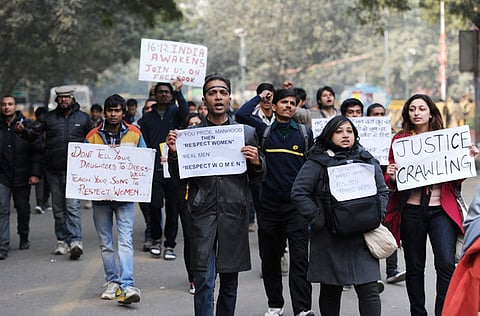The stigma of ‘rape culture’
In trying to understand the horror in India, we will do well to define beliefs

What does it mean to be living in a rape culture? In the days and weeks following the gang-rape and evisceration on a Delhi bus of a 23-year-old medical student, who subsequently died from her injuries, many words have been expended, in conversation, in protest and in print, variously offering context for an event so extreme that it seems beyond analysis. These attempts to explain why, whether examining the general treatment of women in India, or the broader reality of sexual violence across the globe, have reached for one phrase again and again, though seldom defined it: Rape culture. And now a working definition is necessary, if we are not to lose the usefulness of this insight in our blanket horror at the outrage that prompted it.
For those protesting outside the Indian High Commission in London again yesterday, the components of rape culture on the sub-continent must be obvious, lurching from Bollywood’s forced seductions to the hundreds of men accused of sexual violence who have stood in state elections in recent years. Since the Delhi assault, Indian women themselves have described a spectrum of assault — constant harassment outside the home, endemic domestic violence, the rape of poor women — the public response to which has been muted until now.
A few western commentators have looked to limit this to a sorry condition of uncivilised nations. However, cultural superiority is not within the purview of countries with a rape conviction rate like Britain’s. The acceptance that sexual violence is a global challenge is not to deny that it may have a local or national character demanding tailored solutions. Understanding rape as a universal phenomenon also means understanding that rape culture not only comprises unambiguous misogyny of the kind laid bare in India.
The term “rape culture” was first used by second-wave feminists of the 1970s, who encouraged women to speak out for the first time about the reality of sexual violence. In the landmark text Against Our Will, Susan Brownmiller described a “rape-supportive culture”, a complex of beliefs that excuse, tolerate or even condone violence against women. The term was dragged out of academe and into popular culture by SlutWalk — protest rallies that began in Canada in 2011 when a Toronto police officer suggested that to remain safe, “women should avoid dressing like sluts”. SlutWalk campaigners define a rape culture as one in which “sexual violence is both made to be invisible and inevitable”.
In practice, rape culture is prevalent in so many Hollywood movies that the British Board of Film Classification is currently reassessing its policy on depictions of sexual violence. It is a charity dedicated to the ethical treatment of animals using images of violence against women to promote going vegan. It is, I think, comic Jimmy Carr’s “What do nine out of 10 people enjoy? Gang-rape”.
At an institutional level, rape culture is the irony that, in Britain, there is already some of the best sex crimes legislation in Europe, but a judiciary that refuses to apply it, a police service that will not enforce it and a government that is too busy cutting funding for rape crisis centres to recognise that without pressure from the top, there is no incentive for change. It is the Californian court that last week overturned a man’s conviction for raping a sleeping woman because the consent statute does not apply to unmarried victims. And it is the people who are meant to protect you making rape avoidance a solely female responsibility, like the Indian police chief who recently suggested women carry chilli powder to discourage attackers.
Most toxically, rape culture is the existence and reinforcement of myths about the kind of people who rape, the kind of people who get raped and the kind of behaviour that results in an assault. It is the slut-shaming and victim-blaming that, unconsciously or not, colours our individual responses to the statement: I was raped.
We know that the majority of sexual assaults are perpetrated by someone known, if only recently or vaguely, to the victim. Researchers have found that a small number of men commit large numbers of acquaintance rapes, many of them deliberately targeting intoxicated women then using these pervasive myths to avoid prosecution. For this reason, above all others, it is important to talk, not just about rape, but about rape culture.
In fact, all rapes are carried out by a small number of men. Rapists are in the minority. This is not about men’s innate aggression. Nor is it about women’s paranoia. And it isn’t an invention of feminists who do not like Jimmy Carr’s haircut. A measured response to rape culture does not make all men responsible for rape, just as it should not make all women responsible for getting or not getting raped. It involves calling out rape myths in conversation, removing our custom from the organisations that offend us, holding police and politicians to account. And insisting that there is nothing culturally relative about sexual violence. In defining our terms as clearly as possible, we can all counter the mood music that makes rape easier to perpetrate and harder to prosecute.
— Guardian News & Media Ltd
Libby Brooks is acting comment editor of the Guardian.
Sign up for the Daily Briefing
Get the latest news and updates straight to your inbox


